On New Year's Eve, I talked for a while about my imminent trip to New Zealand with Doug Kleinman (my cousin, for those of you who don't know him), who had spent some time in the antipodes himself. Of all the things he said, I was most intrigued with his mention of a friend of Aunt Ann's he had met in Wellington. I didn't have a single contact, let alone one in Wellington, and was ready to jump on any I could find. So I got Aunt Ann's email from Mom and shot off an inquiry.
The resultant conversation was a little odd, but really nice. I hadn't seen the lady in years, and hadn't spent any real time around her since I was a much smaller, different person. I don't want to make too much of this-- it was only a few short emails, hardly a bonding experience. But they were the emails of an articulate, intelligent, and nice person. Over the past few years I've been forced several times to admit that I'm damn lucky to be related to all my relatives1. The sensation has yet to grow old. In any case, it had been years since she'd talked to said friend, but she was happy to get in touch for me. A few days later, I had arranged to meet one Mr. Phil Capper (see title) for an orientation of sorts when I arrived in Wellington.
Now, if any of you get the chance to be given a tour of a city by a longtime resident who is also a professional academic in the social sciences, I recommend you jump on it. If said professional academic is also unfailingly friendly, nice, and interesting and has a charming touch of that birdlike fidgety awkwardness people call "professorial", I insist you jump on it. I didn't just get the rundown of the physical geography of the city-- dude got out his socio-economic, political, and historical crayons and colored in whatever seemed relevant and/or interesting2. Highlights:
* Happy Valley, where the hills always block the sun and where police tend to start dragnets3.
* An abridged history of Anglo-Maori relations.
BRIEF, SLOPPY SUMMATION: As the initial English port settlements expanded in typical imperialist fashion, several Maori tribes got together and decided to be politically proactive. They signed the Treaty of Waitangi, which accepted British sovereignty on the grounds of British protection (from each other as much as anything. Lord, but the Maori were fighters) and fair compensation for Maori land. Now, initially this got about the same respect its American counterparts were shown (minus some genocide, I guess ), but later, some folks dug that old treaty up, and decided to take it seriously and treat it as the founding document of modern New Zealand. New Zealand has undertaken a serious attempt to make good on those promises of compensation-- many millions and some clever investments later, several tribes have become powerful voices in Kiwi politics. END OF B.S.S.
* One tribe, known as particularly vicious warriors, has taken to producing many ferociously smart academic radicals, who reject the sovereignty of the nation-state of New Zealand on the grounds that their tribe never signed the treaty of Waitangi. This argument has not swayed the courts of the nation-state of New Zealand, which might have meant something if all concerned parties considered themselves within their jurisdiction.
* Wellington has a town belt of forest that got planned out decades ago. The city has grown beyond its confines, but it's still possible to walk all day and not step foot out of the woods. In fact, most of the forest footage in "Lord of the Rings" was filmed within Wellington city limits.
* They really take their ecology seriously here. Makes sense, for an island with no native predator worth the title and a rural economy. There is an island in the harbor that was used for decades for quarantining animals4, and a bird preserve with a seriously thought-out predator-proof fence. It has awfully fine mesh, goes far enough underground to prevent tunneling under, and has a cap of sorts to stop anything climbing over. There is also a 5,000 year (that is not a typo) plan for establishing native old-growth vegetation. Someone has a pretty optimistic view of climatic stability.
Afterwards, we headed back to the Capper apartment for coffee and conversation. Phil and his wife (who is also terribly nice, which makes it even more mortifying that I've forgotten her name) live just a few blocks away from me. We talked about academia, New Zealand's badass Wild West (per capita, way more gnarly than Earp-era Arizona), flickr, Moomins5, and so on. At the end of the evening, I was very politely kicked out and invited to dinner the next day.
Dinner was a lovely lamb roast. My vegetarianism centers on an objection to the ethical and ecological problems of factory farming-- New Zealand's pasture-raised sheep are totally fair game, and delicious with mint sauce. It was a lazy day compared with the last one-- while dinner was cooking itself (offers of help were met with smiling resistance), I dashed through the first three volumes of Moomin comics, and ended the evening with a postprandial cricket match. New Zealand was putting a hurting on the almighty Australian team6, and Phil gave me a fairly thorough explanation of the sport and its lingo, my impressions of which will probably take a whole post of their own. I mean, I went on for long enough about surfing, and here I actually know what I'm talking about.
1. Good job, all y'all. Seriously, every dang one of you.
2. If you think that this would be a perfect opportunity to take a bunch of pictures showing the character and breadth of Wellington, you would be right. If you also think that I can be a pretty absent-minded dude who can forget obvious things like cameras, you would be right again.
3. Police tend to start dragnets there because police tend to end dragnets there.
4. Except a brief, shameful period in WWII, when it was used to quarantine humans. Not that America can exactly take the upper ground here.
5. The Cappers have a plush Moominmamma and Moominpappa that travel with them. That is adorable and this is my last footnote. I promise.
6. So I lied. This upset, though, is the emotional and athletic equivalent of the Sox sweeping the '98 Yankees, if the Sox had the Astros' roster.
Thursday, April 2, 2009
Thursday, March 5, 2009
Wellington, Ho!
(I've been having a bit of trouble writing this entry. Part of the problem is that, out of a sense of continuity if nothing else, I feel like I ought to sum up Wellington in a few pithy paragraphs. I've been here long enough that I let my first impressions wear out a bit, but not long enough to really feel like I've got a firm handle on the city as a whole. Also, I have more of a social life here than I had traveling with Mike, who, however friendly and compatible, never really crossed the mental line dividing friendly from friend, leaving me less time to sit in front of a computer screen and just process things. Laziness, of course, has had no part in the process.
More to the point, though, my experience in Wellington can't be summed up in a single post, because it hasn't been and will not be a singular experience. It's going to keep on evolving through the end of summer, through fall and winter, as I get a job and a flat and new friends. And so, the first of many:)
While Coromandel still holds first place for driving, Route 1 south into Wellington is a pretty tremendous road in its own right. It doesn't have the rugged coastal bits or the lush, shifting subtropical backdrop (nothing against temperate vegetation, I'm just used to it); it compensated with a lot of cars. Mike was happy to let me handle the mountain traffic, and I was happy to take over driving*.
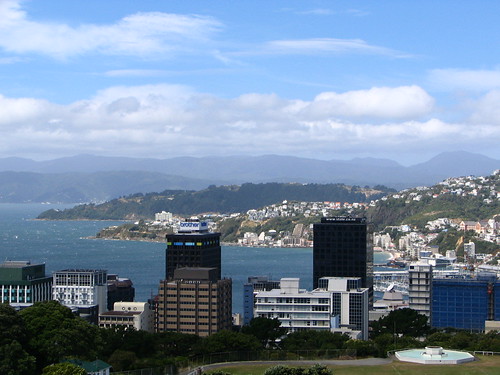
Once we reached the city proper, we managed to get lost almost immediately in steep, tortuous residential roads ("Terraces", rather, which should have been a tip-off). Both of us were inclined towards the small, bohemian hostels just north of the city center, but there was no room in the inns. With dinnertime and a Stereolab concert creeping ever closer, we settled on Wellywood, a zebra-striped tower smack in the middle of the city. Having now lived here for some weeks, I can say that it is a place utterly without charm. It is remarkably convenient, though: it has free internet, fair rates, a fine location, and some good people. The transient nature of most of its inhabitants leads to a bizarre ad hoc culture among a core of long-term residents, but more on that in a later post.
We found an overnight parking spot and a grocery store; we ate and showered and changed clothes; we were ready for the show.
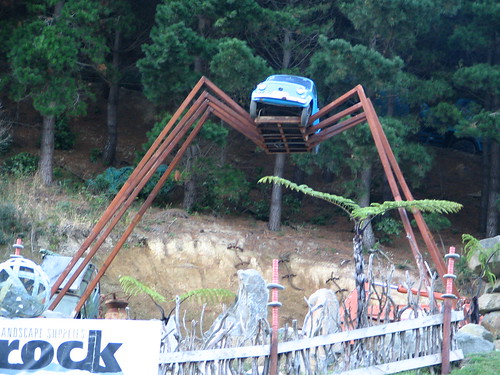
The venue, San Francisco Bath House, was on Cuba St., the pedestrian mall and heart of downtown Wellington**. It was very much akin to American indie music venues. Something was wrong, though. It was too clean, the bar served good beer (I heartily recommend Mac's Sassy Red, and not just because of the name), and the hipsters seemed just a bit too nice. The floor wasn't sticky, not even a little bit, and everyone had just a bit of elbow room. Granted, Stereolab brought an older crowd, but still.
Coming in, I caught the end of the starting act-- a local lady with a keyboard and some half-written songs. She was amateurish and inconsistent in a way that was charming and maddening in turns. Every song had brilliant moments that, distilled and built around well, would make for beautiful, distinctive music-- droning electronic ballads, equal parts Dan Deacon, Slowdive and Low. Unfortunately though, it was a set of forgettable meandering punctuated by brilliance, not the other way around. But she had promise, and she had a stage set up that I really, honestly, truly want to steal. She stood in the middle of the stage with her keyboard, her laptop and microphone, bookended by a pair of old computer monitors, each of which showed the waveform of one recorded track of the song she was playing. The drum beats in particular looked amazing, and the presentation of the waveforms combined visual interest and reinforcement of the music in a way that managed to remind me simultaneously of backup dancers and sheet music.
Stereolab put on the kind of show half of all music clichés exist to describe. I don't exactly mean that it was good, though it very much was. But the band and crowd got into a wonderful, giddy sort of positive feedback loop, where they were excited to be here and we were excited they were here and they were excited we were excited and so forth. The band played like they'd been together eighteen years (which, in fact, they have), and looked like it had been half that. Clean living, I expect. Everyone smiled a lot and their frontwoman called Wellington a "special place" at least three times. Man, oh man.
* One constant in my talks and emails about Wellington was a comparison to San Francisco, a city I only know by the words and pictures of other people. But given the vagaries of city streets and Mike's somewhat underwhelming performance driving hills out in the country, I wanted to be the one behind the wheel (or rather, the clutch pedal) when we arrived. This decision payed off on every steep hill start, and payed off double when it came time to make a tight, uphill parallel park in traffic.
** Like a squid, Wellington has multiple hearts. Cuba Street is the cultural one; if you're into party bars, Courtney Place is another; for politics, the Capital and Parliament; for criminals, Happy Valley.
More to the point, though, my experience in Wellington can't be summed up in a single post, because it hasn't been and will not be a singular experience. It's going to keep on evolving through the end of summer, through fall and winter, as I get a job and a flat and new friends. And so, the first of many:)
While Coromandel still holds first place for driving, Route 1 south into Wellington is a pretty tremendous road in its own right. It doesn't have the rugged coastal bits or the lush, shifting subtropical backdrop (nothing against temperate vegetation, I'm just used to it); it compensated with a lot of cars. Mike was happy to let me handle the mountain traffic, and I was happy to take over driving*.

Once we reached the city proper, we managed to get lost almost immediately in steep, tortuous residential roads ("Terraces", rather, which should have been a tip-off). Both of us were inclined towards the small, bohemian hostels just north of the city center, but there was no room in the inns. With dinnertime and a Stereolab concert creeping ever closer, we settled on Wellywood, a zebra-striped tower smack in the middle of the city. Having now lived here for some weeks, I can say that it is a place utterly without charm. It is remarkably convenient, though: it has free internet, fair rates, a fine location, and some good people. The transient nature of most of its inhabitants leads to a bizarre ad hoc culture among a core of long-term residents, but more on that in a later post.
We found an overnight parking spot and a grocery store; we ate and showered and changed clothes; we were ready for the show.

The venue, San Francisco Bath House, was on Cuba St., the pedestrian mall and heart of downtown Wellington**. It was very much akin to American indie music venues. Something was wrong, though. It was too clean, the bar served good beer (I heartily recommend Mac's Sassy Red, and not just because of the name), and the hipsters seemed just a bit too nice. The floor wasn't sticky, not even a little bit, and everyone had just a bit of elbow room. Granted, Stereolab brought an older crowd, but still.
Coming in, I caught the end of the starting act-- a local lady with a keyboard and some half-written songs. She was amateurish and inconsistent in a way that was charming and maddening in turns. Every song had brilliant moments that, distilled and built around well, would make for beautiful, distinctive music-- droning electronic ballads, equal parts Dan Deacon, Slowdive and Low. Unfortunately though, it was a set of forgettable meandering punctuated by brilliance, not the other way around. But she had promise, and she had a stage set up that I really, honestly, truly want to steal. She stood in the middle of the stage with her keyboard, her laptop and microphone, bookended by a pair of old computer monitors, each of which showed the waveform of one recorded track of the song she was playing. The drum beats in particular looked amazing, and the presentation of the waveforms combined visual interest and reinforcement of the music in a way that managed to remind me simultaneously of backup dancers and sheet music.
Stereolab put on the kind of show half of all music clichés exist to describe. I don't exactly mean that it was good, though it very much was. But the band and crowd got into a wonderful, giddy sort of positive feedback loop, where they were excited to be here and we were excited they were here and they were excited we were excited and so forth. The band played like they'd been together eighteen years (which, in fact, they have), and looked like it had been half that. Clean living, I expect. Everyone smiled a lot and their frontwoman called Wellington a "special place" at least three times. Man, oh man.
* One constant in my talks and emails about Wellington was a comparison to San Francisco, a city I only know by the words and pictures of other people. But given the vagaries of city streets and Mike's somewhat underwhelming performance driving hills out in the country, I wanted to be the one behind the wheel (or rather, the clutch pedal) when we arrived. This decision payed off on every steep hill start, and payed off double when it came time to make a tight, uphill parallel park in traffic.
** Like a squid, Wellington has multiple hearts. Cuba Street is the cultural one; if you're into party bars, Courtney Place is another; for politics, the Capital and Parliament; for criminals, Happy Valley.
Sunday, February 15, 2009
I Took the Pictures When I Got Picked Up
I cannot believe I forgot my camera in Napier.
Or rather, I forgot my camera before Napier. I left it in the car when Mike dropped me off. He was spending the weekend with friends working a nearby white river rafting joint. Faced with a choice between spending the next few days with a bunch of unknown Canucks and getting to see arguably the best city-wide example of Art Deco architecture in the world, I chose Art Decoville.
And I forgot my camera.
Napier's architecture is the silver lining of a disaster that just celebrated its 77th anniversary. On February 3rd, 1931 (ah, Wikipedia), Hawke's Bay was hit with a 7.9 earthquake. The ruination was thorough, and at least 256 people died. But with the slate thus wiped clean, Napier set about a tremendous rebuilding.
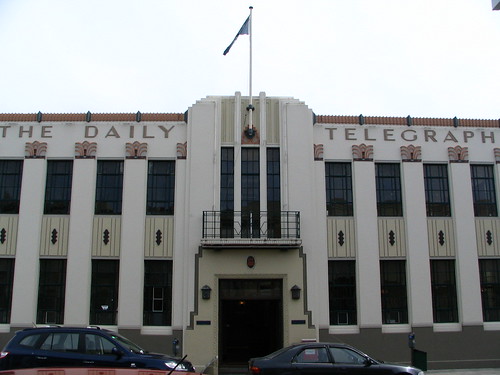
Now, as far as tragedies go, this one had much more upside than the average. First off, it drained a nearby lagoon, enlarging the city's footprint by a good 40 km^2. It also had damn fine timing. Art Deco was a hot new style and there were heaps of talented architects with greatly depressed careers willing to travel halfway across the world for a pretty little devastated port town. A decade or two ago, people took notice of those buildings under the faded paint. Napier held a few bake sales, tidied itself up, and became New Zealand's first World Heritage Site.

And my, how people took notice. I stayed at a place called the Criterion Art Deco Backpackers, which was just down the street from Deco Retail, Art Deco Salon, and, of course, the Art Deco Center. It was the top floor (the city held itself to an unofficial two-story limit; sensible, but given that my biggest touchstone for Art Deco architecture is the Chrysler Building, a damn shame) of a charming Spanish Mission building, had a spacious common room and always felt as though it only held half as many guests as were actually booked. I was still feeling fairly sore and wilted from the previous day's epic, so I spent most of my time relaxing here. I wandered around looking at buildings, of course, and visited the aquarium, where I walked through a glass tunnel under the oceanarium ogling sharks and saw the corpse of a Giant Squid (and I forgot my camera!).
But Napier was still somehow underwhelming. It's hard to pin down exactly why-- it was a gorgeous, sunny city by the ocean, it was incredibly aesthetically consistent and interesting, it was cleverly planned and charming almost to a fault. Part of it was the over-use of pastels, however period-correct. Mostly, though, it just felt too self-conscious as a city. Coming in, I flirted with the notion of staying here if Wellington didn't work out. Coming out, it felt like living here would be a bit like marrying Tammy Faye Bakker*. Napier was awfully pretty; if only it took off its makeup and relaxed a bit, it would be ideal.
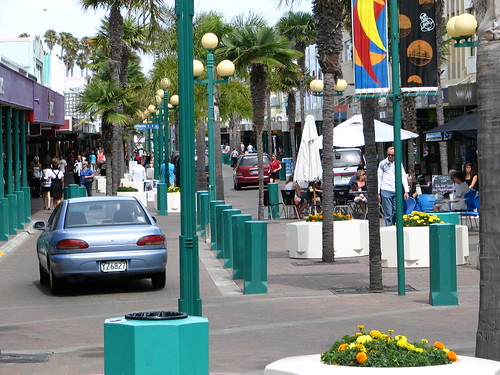
*Yes, I realize how flawed this analogy is, but I couldn't think of a more iconic wearer of makeup, so it's the analogy you're getting.
Or rather, I forgot my camera before Napier. I left it in the car when Mike dropped me off. He was spending the weekend with friends working a nearby white river rafting joint. Faced with a choice between spending the next few days with a bunch of unknown Canucks and getting to see arguably the best city-wide example of Art Deco architecture in the world, I chose Art Decoville.
And I forgot my camera.
Napier's architecture is the silver lining of a disaster that just celebrated its 77th anniversary. On February 3rd, 1931 (ah, Wikipedia), Hawke's Bay was hit with a 7.9 earthquake. The ruination was thorough, and at least 256 people died. But with the slate thus wiped clean, Napier set about a tremendous rebuilding.

Now, as far as tragedies go, this one had much more upside than the average. First off, it drained a nearby lagoon, enlarging the city's footprint by a good 40 km^2. It also had damn fine timing. Art Deco was a hot new style and there were heaps of talented architects with greatly depressed careers willing to travel halfway across the world for a pretty little devastated port town. A decade or two ago, people took notice of those buildings under the faded paint. Napier held a few bake sales, tidied itself up, and became New Zealand's first World Heritage Site.

And my, how people took notice. I stayed at a place called the Criterion Art Deco Backpackers, which was just down the street from Deco Retail, Art Deco Salon, and, of course, the Art Deco Center. It was the top floor (the city held itself to an unofficial two-story limit; sensible, but given that my biggest touchstone for Art Deco architecture is the Chrysler Building, a damn shame) of a charming Spanish Mission building, had a spacious common room and always felt as though it only held half as many guests as were actually booked. I was still feeling fairly sore and wilted from the previous day's epic, so I spent most of my time relaxing here. I wandered around looking at buildings, of course, and visited the aquarium, where I walked through a glass tunnel under the oceanarium ogling sharks and saw the corpse of a Giant Squid (and I forgot my camera!).
But Napier was still somehow underwhelming. It's hard to pin down exactly why-- it was a gorgeous, sunny city by the ocean, it was incredibly aesthetically consistent and interesting, it was cleverly planned and charming almost to a fault. Part of it was the over-use of pastels, however period-correct. Mostly, though, it just felt too self-conscious as a city. Coming in, I flirted with the notion of staying here if Wellington didn't work out. Coming out, it felt like living here would be a bit like marrying Tammy Faye Bakker*. Napier was awfully pretty; if only it took off its makeup and relaxed a bit, it would be ideal.

*Yes, I realize how flawed this analogy is, but I couldn't think of a more iconic wearer of makeup, so it's the analogy you're getting.
Wednesday, February 4, 2009
Turangi Vice
From Taupo we drove an hour south to Turangi. Not the town itself, a quiet collection of lawns and fishing shops that close early, but to Tongariro Holiday Park. It cost about the same as a hostel per night, but was much more akin to the campgrounds of family roadtrips past. There were RVs, which are rather more modest creatures than their American counterparts, and places to pitch a tent if one is so equipped and inclined. We set up in a rather unassuming little room featuring a single bed bunked atop a double. When Mike asked which I would prefer, I magnanimously took the bigger one. The local grocery store had closed, so our only option for food was the in-house restaurant run by a gruff, tattooed piece of gristle named Greg. Despite his deep underlying friendliness, Mike was quite intimidated by him. He would be perfect as a tangential presence at Work Gang. Thinking of the free ranging cows dotting the landscape, I ordered a burger-- it came with cheese, onions, a tomato, and some beets. Beets on burgers is apparently a Kiwi staple. One of the more inspired ones, I think.
The next morning (far too early the next morning-- we were breakfasted and gone by 7:30) we set out for the famous Tongariro Crossing, reputed to be one of the best one-day hikes the country has to offer. I had wool socks and Mike had boots, so between us we were properly equipped. One of the campsite's employees rode with us-- he wasn't insured to drive any passengers on the job, but he was insured to drive the car to us at the end of the trail and get a ride home. Quite a clever system, really.
At the trailhead, we slathered our exposed bits with sunscreen and went to the tap to top off our water bottles, at which point I discovered I had forgotten mine. This was, in fact, a huge deal. We were facing a day-long trek, the majority of which was sandy, exposed desert with only a liter of water between us. Luckily, a nearby trash can overflowed with the empties of crossers previous, and I got to learn how much sooner I get over my compunctions about germs than my companion (about 4 minutes sooner).
And so we set out. On paper, the crossing took seven hours-- being slim young men, we figured we could fit in one of the three volcanoes along the trail and still be done in time to buy groceries. It seemed like a good idea at the time. I lobbied for Mt. Ngauruhoe because its steep, symmetrical slopes were the most picturesque and its loose, scree-covered surface seemed like an interesting challenge. It was so picturesque, in fact, that it played Mt. Doom in the Lord of the Rings movies. If it were any easier to climb, it would have been hopelessly tourist-ridden.
By the time we arrived at the base of Ngauruhoe, it had become clear Mike's blithe assumption that walking around a flat city completely prepared one for walking around mountainous terrain hadn't been borne out. Not a problem, but a bit of a letdown: I had been looking forward to a more demanding clip on my first camper-free hike in years. The amount of latitude we had to pick our own trail was surprising at first, but given the desolation of the rocky, volcanic terrain it made sense. A bit of wisdom gleaned from an old man I met on the slope: stay tight to the people ahead of you when there's a lot of loose rock, so that there isn't room for the inevitable dislodgings to gather speed.
During our climb we also met a man wearing a ring on a necklace. Mike posited he was a recent divorcée on a quest to throw his wedding ring into Mt. Doom, which more than made up for the bad driving.
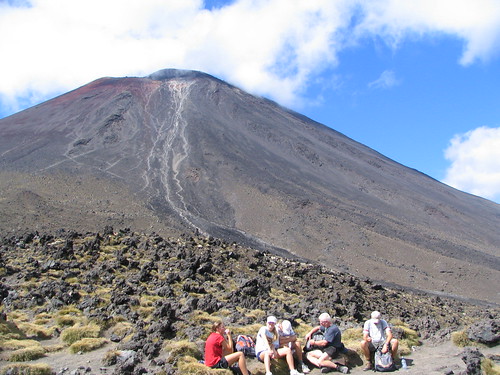
The view wasn't bad either:
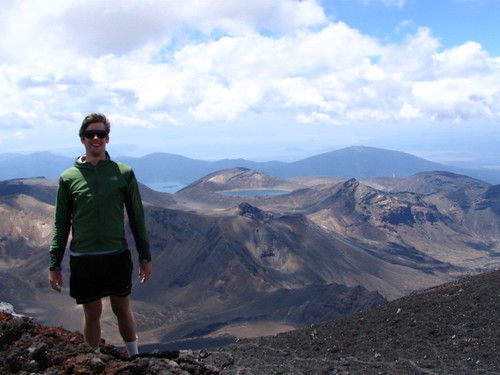
The descent was fantastic. Between the zigzag route and the many stops we (Mike, the old man, his son and I) took, going up took rather longer than the two hours the car guy had said. Going down, however, took a little less than the predicted twenty minutes. Descending in scree is wonderful fun-- where each step slid down four inches going up, they slid at least a foot going down. You hop from foot to foot, riding a tiny rockslide of your own creation. I decided I had earned some fun and stretched my legs out a little on the way down, outpacing my shorter, more timid companion. It seemed like a good idea at the time. The trail down ended a few hundred meters back from the Mt. Ngauruhoe trailhead. After shaking out the kilo of rocks collected in my shoes, I sat in the shade of a large rock and waited for Mike. And waited. And waited. I walked up the trail to where we had started. And waited. For an hour and a half, frustration mounting, I walked back and forth between spots, looking for the man. I could feel the backs of my knees starting to burn from facing up towards the slope so long, but the sunscreen was in Mike's bag. My water supply dwindled. I finally asked some Irish folks coming down if they'd seen anyone matching his description, and they had seen no one at all on the way down. I was the one with the cellphone to call our ride, and if we were to have any chance of a reasonably-priced dinner, I had to get a move on and hope Mike was ahead of me and not on the slope with a broken leg.
There were some really tremendous sights over the following few kilometers-- the Red Crater especially. The sun was behind a cloud when I took its photo-- it really doesn't do justice to the deep, rich red, the contrast of the grey hollow, or the sheer impact of the crater's steep plunge down from your feet as you perch on its highest lip. But I really didn't have any time to wait for better lighting.
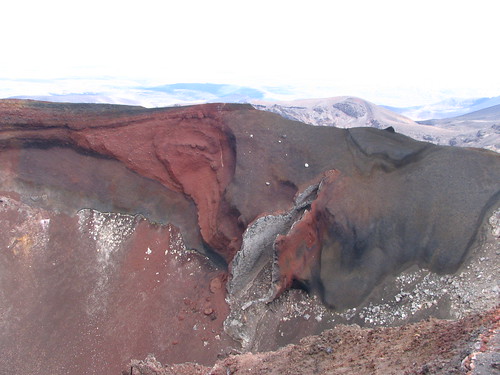
The Emerald Lakes, in contrast, were lit beautifully and smelled like rotten eggs.
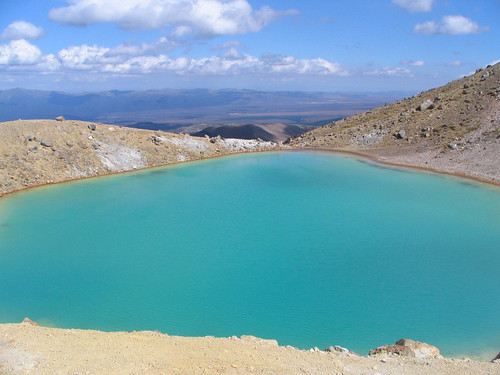
For the rest of the hike, things grew ever more verdant and stressful. On one hand, I got to set as fast a pace as I wanted (faster, even); on the other, I had caught neither sight nor smell of Mike, and dehydration was catching up to me. I got awfully cranky and even said some bad words. Gradually, though, the kilometers on the signposts counted down; trees grew to shade my sunburns (last time I leave the sunscreen with someone else); I found a spigot to refill my water. Rounding a corner, I saw within a hundred meters posts marking the trail's end and beyond them, cars. Scurrying forward, I entered the shelter at the carpark. Mike was nowhere to be found. I took off my shoes; I said more bad words. Five minutes later, a beautiful, dingy red sedan pulled up.
Given that I descended rather faster than Mike, I can't spot him the full hour and a half. Furthermore, he waited at the base of the trail up Mt. Ngauruhoe for 15-20 minutes I spent at the base of the trail down. I figure he had an hour head start. The whole time he was convinced I was ahead of him, so he hiked all extra fast. Bragging isn't polite, but I think I did a heck of a job getting to the trailhead within ten minutes of him. We even had time to get groceries.
The next morning (far too early the next morning-- we were breakfasted and gone by 7:30) we set out for the famous Tongariro Crossing, reputed to be one of the best one-day hikes the country has to offer. I had wool socks and Mike had boots, so between us we were properly equipped. One of the campsite's employees rode with us-- he wasn't insured to drive any passengers on the job, but he was insured to drive the car to us at the end of the trail and get a ride home. Quite a clever system, really.
At the trailhead, we slathered our exposed bits with sunscreen and went to the tap to top off our water bottles, at which point I discovered I had forgotten mine. This was, in fact, a huge deal. We were facing a day-long trek, the majority of which was sandy, exposed desert with only a liter of water between us. Luckily, a nearby trash can overflowed with the empties of crossers previous, and I got to learn how much sooner I get over my compunctions about germs than my companion (about 4 minutes sooner).
And so we set out. On paper, the crossing took seven hours-- being slim young men, we figured we could fit in one of the three volcanoes along the trail and still be done in time to buy groceries. It seemed like a good idea at the time. I lobbied for Mt. Ngauruhoe because its steep, symmetrical slopes were the most picturesque and its loose, scree-covered surface seemed like an interesting challenge. It was so picturesque, in fact, that it played Mt. Doom in the Lord of the Rings movies. If it were any easier to climb, it would have been hopelessly tourist-ridden.
By the time we arrived at the base of Ngauruhoe, it had become clear Mike's blithe assumption that walking around a flat city completely prepared one for walking around mountainous terrain hadn't been borne out. Not a problem, but a bit of a letdown: I had been looking forward to a more demanding clip on my first camper-free hike in years. The amount of latitude we had to pick our own trail was surprising at first, but given the desolation of the rocky, volcanic terrain it made sense. A bit of wisdom gleaned from an old man I met on the slope: stay tight to the people ahead of you when there's a lot of loose rock, so that there isn't room for the inevitable dislodgings to gather speed.
During our climb we also met a man wearing a ring on a necklace. Mike posited he was a recent divorcée on a quest to throw his wedding ring into Mt. Doom, which more than made up for the bad driving.

The view wasn't bad either:

The descent was fantastic. Between the zigzag route and the many stops we (Mike, the old man, his son and I) took, going up took rather longer than the two hours the car guy had said. Going down, however, took a little less than the predicted twenty minutes. Descending in scree is wonderful fun-- where each step slid down four inches going up, they slid at least a foot going down. You hop from foot to foot, riding a tiny rockslide of your own creation. I decided I had earned some fun and stretched my legs out a little on the way down, outpacing my shorter, more timid companion. It seemed like a good idea at the time. The trail down ended a few hundred meters back from the Mt. Ngauruhoe trailhead. After shaking out the kilo of rocks collected in my shoes, I sat in the shade of a large rock and waited for Mike. And waited. And waited. I walked up the trail to where we had started. And waited. For an hour and a half, frustration mounting, I walked back and forth between spots, looking for the man. I could feel the backs of my knees starting to burn from facing up towards the slope so long, but the sunscreen was in Mike's bag. My water supply dwindled. I finally asked some Irish folks coming down if they'd seen anyone matching his description, and they had seen no one at all on the way down. I was the one with the cellphone to call our ride, and if we were to have any chance of a reasonably-priced dinner, I had to get a move on and hope Mike was ahead of me and not on the slope with a broken leg.
There were some really tremendous sights over the following few kilometers-- the Red Crater especially. The sun was behind a cloud when I took its photo-- it really doesn't do justice to the deep, rich red, the contrast of the grey hollow, or the sheer impact of the crater's steep plunge down from your feet as you perch on its highest lip. But I really didn't have any time to wait for better lighting.

The Emerald Lakes, in contrast, were lit beautifully and smelled like rotten eggs.

For the rest of the hike, things grew ever more verdant and stressful. On one hand, I got to set as fast a pace as I wanted (faster, even); on the other, I had caught neither sight nor smell of Mike, and dehydration was catching up to me. I got awfully cranky and even said some bad words. Gradually, though, the kilometers on the signposts counted down; trees grew to shade my sunburns (last time I leave the sunscreen with someone else); I found a spigot to refill my water. Rounding a corner, I saw within a hundred meters posts marking the trail's end and beyond them, cars. Scurrying forward, I entered the shelter at the carpark. Mike was nowhere to be found. I took off my shoes; I said more bad words. Five minutes later, a beautiful, dingy red sedan pulled up.
Given that I descended rather faster than Mike, I can't spot him the full hour and a half. Furthermore, he waited at the base of the trail up Mt. Ngauruhoe for 15-20 minutes I spent at the base of the trail down. I figure he had an hour head start. The whole time he was convinced I was ahead of him, so he hiked all extra fast. Bragging isn't polite, but I think I did a heck of a job getting to the trailhead within ten minutes of him. We even had time to get groceries.
Tuesday, January 27, 2009
Next Stop Mt. Doom
"Taupo nestles among spectacular natural wonders," say the Lonely Planeteers. They're not wrong, but they're not giving you the full picture. Squatting on the shore of its eponymous lake, Taupo is a venus tourist trap, luring young and old with its lovely environs and dissolving their money away in its jetboats and skydives and tours and rentals and tourist bars.
And so we only spent one night in Taupo, hanging out with a few Swiss guys, a Scot and a Brit. I'm being overly dismissive here-- everyone I met there was friendly and genuinely wanted you to have a good time. But too much of the city seemed the result of calculated capitalism. Shiny and plastic. A guy named Vegas Brown played competent, uninspired covers to a drunkenly receptive crowd next door to the hostel.
To be fair, this was the weekend of the big A1 race, and it was trying to get its full Reno on for the drivers of medium-engined fighter jet cars. The race sounded like a cool system, actually-- a bit less powerful than F1, but similar, teams weren't fielded by sponsors but by countries. Lots of posters to be found of the Team New Zealand Black Beauty, powered by Ferrari. I thought seriously about watching a race for almost half an hour before I gave up the idea as silly.
And so we only spent one night in Taupo, hanging out with a few Swiss guys, a Scot and a Brit. I'm being overly dismissive here-- everyone I met there was friendly and genuinely wanted you to have a good time. But too much of the city seemed the result of calculated capitalism. Shiny and plastic. A guy named Vegas Brown played competent, uninspired covers to a drunkenly receptive crowd next door to the hostel.
To be fair, this was the weekend of the big A1 race, and it was trying to get its full Reno on for the drivers of medium-engined fighter jet cars. The race sounded like a cool system, actually-- a bit less powerful than F1, but similar, teams weren't fielded by sponsors but by countries. Lots of posters to be found of the Team New Zealand Black Beauty, powered by Ferrari. I thought seriously about watching a race for almost half an hour before I gave up the idea as silly.
At Least This Time I Didn't Get Sunburned
En route to Taupo, we stopped in Waitomo to go Black Water Rafting, so called because it happens underground. It also happens on inner tubes, but Black Water Tubing doesn't have quite the same cachet. Sadly, and practically, we couldn't take our own cameras and I wasn't about to throw down $20 for someone else's souvenir photos of me, so you'uns will have to do without. The two guides, Alen and Chad, were inveterate trash-talkers who spent the entire introduction and wetsuit fitting trying to soak the other when he wasn't looking.
The tubing itself wasn't quite what I had expected. There was a lot more crawling and walking than I had figured, and one tunnel that was perhaps a cubic foot larger than I am. Right after that, though, we came to a little waterfall off of which, as we had been thoroughly trained, we jumped onto our bums. Once the last of us had landed with a mighty noise and a crash of chilly cave water, we linked up, foot to armpit, turned off our headlamps, and floated along under a canopy of glow worms. Glow worms are a sort of maggot that angles for lost flies, dangling its mucus in gossamer strands and pooping them out as bioluminescent poo. They look like pale blue-green stars scattered across the ceiling, which is exactly as cool as it ought to be. At the end of the trip Chad and Alen took us up to a 3m high ledge and had us butt-jump off. The ceiling was at most 4 feet high above the edge; I'm unconvinced I cut a dignified figure as I inched backwards to the edge, doubled over completely with an inner tube encircling my bum. The landing was cold, wet, and resounding. It was more or less a perfect end to the afternoon.
The tubing itself wasn't quite what I had expected. There was a lot more crawling and walking than I had figured, and one tunnel that was perhaps a cubic foot larger than I am. Right after that, though, we came to a little waterfall off of which, as we had been thoroughly trained, we jumped onto our bums. Once the last of us had landed with a mighty noise and a crash of chilly cave water, we linked up, foot to armpit, turned off our headlamps, and floated along under a canopy of glow worms. Glow worms are a sort of maggot that angles for lost flies, dangling its mucus in gossamer strands and pooping them out as bioluminescent poo. They look like pale blue-green stars scattered across the ceiling, which is exactly as cool as it ought to be. At the end of the trip Chad and Alen took us up to a 3m high ledge and had us butt-jump off. The ceiling was at most 4 feet high above the edge; I'm unconvinced I cut a dignified figure as I inched backwards to the edge, doubled over completely with an inner tube encircling my bum. The landing was cold, wet, and resounding. It was more or less a perfect end to the afternoon.
Monday, January 26, 2009
Plus, Glow Worms
So it turns out surfing is as awesome as everyone says. I'm learning at Raglan, home to the world's longest left-hand break, where children learn to surf from the age of five. In gym class.
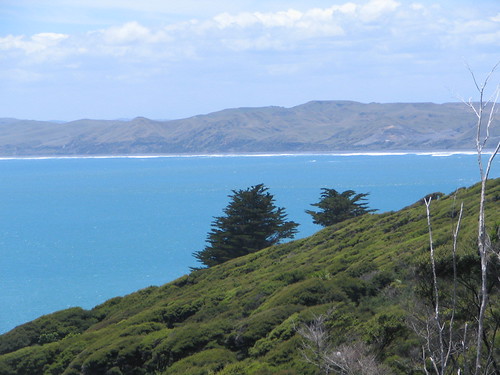
It's tiring as the dickins, though. For every minute you spend standing on your board (assuming you catch every wave you try, which is a laughable assumption at this stage in my surfing career), you spend about five getting out there. But this ratio only applies to a tiny slice of intermediate surfers, because beginners will fall over more often than not, sometimes after riding a third of the way back to shore, and better surfers are going to both go farther out and be more selective about waves. So expect to spend a good ten to fifteen minutes slogging through water, fighting currents and crosscurrents and waves. And as you get deeper, not only does the water pull harder at more of your body, ever taller waves batter you until you have no choice but to throw your board in front of you, jump, and hope you'll ride it out and not take another body blow. It's pretty awesome, actually-- like hiking, football and wave mechanics up and had a baby together.
Once you get out as far as you can/dare, you turn your board around and wait for a wave. When you see one 5-10m back, you hop on your board and start paddling. Moments later, the coming wave lifts your board and you start sliding forwards down the breaking face of the water. Now you have to (smoothly, mind you, or it's game over and a face-full of brine) lift yourself up and pop up to your feet, with your weight low and centered on your front foot which is in turn just in front of the board's center of balance. But once you start getting the hang of all that, it's wonderful. Nuts to the pow pow gnar gnar (snow, you know I don't really mean that)-- there's a beautiful, intuitive interaction between your mass and the wave. If you feel yourself getting a bit bogged down, you just shift your weight a bit forwards, in front of the wave's crest. The idea is to be going downhill always.
It's like snowboarding powder, with free feet and a constant intuitive calculation where the variables are your body weight, position on the board, water speed and direction and slope. Plus it's a gorgeous summer day and you're surrounded by attractive people in wetsuits and bathing suits and you're just off a long beach of lovely, fine, charcoal-colored sand.
Incidentally, Ugly, if you're looking for something to do next January, come visit me and learn to surf. There is no way it wouldn't be worth the money.
The other really noteworthy thing about my stay here in Raglan is the zipline at the hostel I was at. It's not a very large zip, with just a rope to hold onto and a flat plastic cone that'll support your bum (or feet, if you're particularly adventurous). There's no obnoxious signage or waiver or anything and there's a tire stopper that will bust you in the chops if you're zipping standing up and don't see it coming (don't laugh too much, it was nighttime). It is beautifully pre-litigious, and it simply could not exist as such in the States.

It's tiring as the dickins, though. For every minute you spend standing on your board (assuming you catch every wave you try, which is a laughable assumption at this stage in my surfing career), you spend about five getting out there. But this ratio only applies to a tiny slice of intermediate surfers, because beginners will fall over more often than not, sometimes after riding a third of the way back to shore, and better surfers are going to both go farther out and be more selective about waves. So expect to spend a good ten to fifteen minutes slogging through water, fighting currents and crosscurrents and waves. And as you get deeper, not only does the water pull harder at more of your body, ever taller waves batter you until you have no choice but to throw your board in front of you, jump, and hope you'll ride it out and not take another body blow. It's pretty awesome, actually-- like hiking, football and wave mechanics up and had a baby together.
Once you get out as far as you can/dare, you turn your board around and wait for a wave. When you see one 5-10m back, you hop on your board and start paddling. Moments later, the coming wave lifts your board and you start sliding forwards down the breaking face of the water. Now you have to (smoothly, mind you, or it's game over and a face-full of brine) lift yourself up and pop up to your feet, with your weight low and centered on your front foot which is in turn just in front of the board's center of balance. But once you start getting the hang of all that, it's wonderful. Nuts to the pow pow gnar gnar (snow, you know I don't really mean that)-- there's a beautiful, intuitive interaction between your mass and the wave. If you feel yourself getting a bit bogged down, you just shift your weight a bit forwards, in front of the wave's crest. The idea is to be going downhill always.
It's like snowboarding powder, with free feet and a constant intuitive calculation where the variables are your body weight, position on the board, water speed and direction and slope. Plus it's a gorgeous summer day and you're surrounded by attractive people in wetsuits and bathing suits and you're just off a long beach of lovely, fine, charcoal-colored sand.
Incidentally, Ugly, if you're looking for something to do next January, come visit me and learn to surf. There is no way it wouldn't be worth the money.
The other really noteworthy thing about my stay here in Raglan is the zipline at the hostel I was at. It's not a very large zip, with just a rope to hold onto and a flat plastic cone that'll support your bum (or feet, if you're particularly adventurous). There's no obnoxious signage or waiver or anything and there's a tire stopper that will bust you in the chops if you're zipping standing up and don't see it coming (don't laugh too much, it was nighttime). It is beautifully pre-litigious, and it simply could not exist as such in the States.
Subscribe to:
Posts (Atom)
